1. ENVIRONMENT AND ECOLOGY
- Ecology is a Greek word / meaning: House or living area.
- Ecology word was introduced by Reiter
- Father of Ecology: Ernst Hackal (1869)
- Father of Indian Ecology: R.Misra
Ecology: A Branch of science concerned with the interrelationship of organisms and their environments.
Environmental Biology:
- Environmental biology is the study of how regional groups of animals and plants interact and live within their environment. They also explore the relationship of animals and plants within their species and other species as well.
Eco – system:
- The complex of a community of organisms and its environment functioning as an ecological unit.
- Introduced By: G. Tansley 1935.
Branches:
- Autecology: The branch of ecology that deals with the biological relationship between an individual organism or an individual special its environment.
- Synecology: The ecological study of the relation between natural communities and their environment.
- Gynecology: The study of the gene frequency of a species in relation to its population distribution within a particular environment.
- Paleoecology: The branch of ecology that deals with the interaction between ancient organisms and their environment.
- Applied ecology: Ecology is defined as the branch of science that studies how people or organisms relate to each other and their environment.
- Systems ecology: Ecology a system involving the interactions between a community of living organisms in a particular area and its non-living environment.
- Bio ecology: The study of the interrelations among living organisms in their natural environment; ecology.
ECOSYSTEM
- The system of interaction between living organisms and their environment is termed as ecosystem. It is the unit of the environment.
TYPES OF ECOSYSTEMS
Ecosystem is classified on the basis of the type of organisms and the nature of habitat. The ecosystem are of following types
- Forest ecosystem
- Grassland ecosystem
- Desert ecosystem
- Aquatic ecosystem
- Coastal ecosystem
Forest Ecosystem
It is a land with thick growth of trees. Development of forest is determined by number of climatic factors such as temperature, rainfall, humidity, altitude and availability of sufficient space. About 23% of India’s land is under forest cover. Several types of forests are recognized. The two important types of forest seen in India are tropical rainforest and tropical deciduous forest.
Grassland Ecosystem
- Typical grasslands are characteristics of temperate climates and occur in the Himalayan region in India. The tropical grasslands found in India and elsewhere are the Steppes (shorter species of grass) and Savannas (taller grass species).
Desert Ecosystem
- Desert is a waterless, treeless large land covered with sand. Deserts have extremes of temperature and characteristic fauna and flora. They occur in areas having less than 25 cm rainfall per year. The hot type desert is the Thar Desert in Sindh – Rajasthan, and Cold type is seen in Ladakh and Tibet.
Aquatic Ecosystem
- Aquatic ecosystem is associated with water bodies. Two types of aquatic ecosystems are identified based on the differences in salt content of the waters. They are the marine ecosystem, fresh water ecosystem.
Marine ecosystem
- The marine ecosystem is the largest of all ecosystem and is the most stable one. It is not subjected to severe climatic changes, problems of water supply, food and fire, and human activities like industrialization. However earthquakes under the sea, movement of land masses, eruption of volcanoes in the sea may disturb the marine ecosystem.
- Recent Tsunami had caused severe damage to the marine ecosystem.
Fresh water ecosystem
- These are much smaller and are divisible into two types. They are lentic ecosystem or standing water ecosystem. e.g., ponds, pools, lakes, and swamps and lotic ecosystem or running water ecosystem. e.g., streams, rivers and springs.
Coastal ecosystem
- It includes saline, brackish (mixed saline and fresh) as well as coast lines and adjacent lands.”
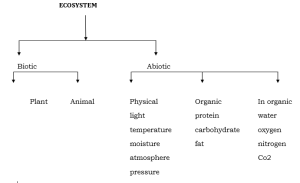
- Natural eco system : pond, meadow, forest, lake, desert
- Artificial eco system : aquarium, park, paddy field.
Biotic factors:
- Classified into three divisions
- All the living things are included
- Plants and animals depend on each other for their life, growth and reproduction
- Ex: Honey Bees depend on flowers for their food.
- Flowers depend on Honey bees for pollination
PRODUCERS:
- They can prepare their food by photosynthesis. ex : plants
- 6 Co2 + 12 H2o → C6H12O6 + 6 O2 + 6 H2O
CONSUMERS:
- These can eat both plants & animals
DECOMPOSERS:
- These can get their food by disintegrated dead plant and animal matter. By this the minerals were reinter into soil.
- Bacteria, fungi (natural scavengers)
Abiotic factors:
- Air, water, soil, light, temperature included in this.
- Plants need light, water and CO2 for their life
- Animals need food, water and O2 for their life
Food Chain
- A food chain is the sequence of who eats whom in a biological community (an ecosystem) to obtain nutrition.
Trophic Levels
- The trophic level of an organism is the position it holds in a food chain.
- Primary producers: Organisms that make their own food from sunlight and/or chemical energy from deep sea vents are the base of every food chain – these organisms are called autotrophs.
- Primary consumers: Are animals that eat primary producers; they are also called Herbivores (plant-eaters).
- Secondary consumers: eat primary consumers. They are Carnivores (meat-eaters) and Omnivores (animals that eat both animals and plants).
- Tertiary consumers: eat secondary consumers.
- Quaternary consumers: eat tertiary consumers.
- Food chains “end” with top predators, animals that have little or no natural enemies.
- When any organism dies, it is eventually eaten by detritivores (like vultures, worms and crabs) and broken down by decomposers (mostly bacteria and fungi), and the exchange of energy continues.
- Some organisms’ position in the food chain can vary as their diet differs. For example, when a bear eats berries, the bear is functioning as a primary consumer.
- When a bear eats a plant-eating rodent, the bear is functioning as a secondary consumer.
- When the bear eats salmon, the bear is functioning as a tertiary consumer (this is because salmon is a secondary consumer).
- since salmon eat herring that eat zooplankton that eat phytoplankton, that make their own energy from sunlight).
- Think about how people’s place in the food chain varies – often within a single meal.
Food Chain in Meadows:
Paddy Rat Snake Kite
(producer) (herbivore) (Primary carnivore) (Secondary carnivore)
Food Chain in Forest:
Grass Rabbit Wolf Tiger
(producer) (primary consumer) (primary carnivore) (Secondary carnivore)
Food Chain in Pond:
phytoplankton insect small fish Big fish Humans
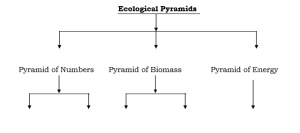
Upright Inverted Upright Inverted Upright only (10% law) Only 10% energy transferred from one trophic level to another trophic level.
FOOD PYRAMID
- The graphic representation of food chain
- It is of two types
Up Pyramid – Terrestrial
heterotroph Omnivores – bacteria – fourth trophic level – 1kg
– 10 joule
Carnivores – snake – third trophic level
– 10kg – 100 joule
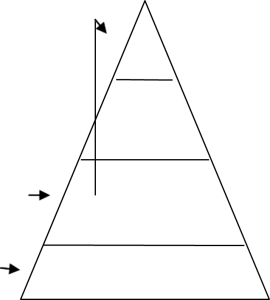
herbivores – insects – second trophic level
|
– 100kg – 1000 joule
producers – plant – first trophic level – 1000kg
auto trophs – 10000 joule
10 % Law is given by : Lindemamn 1942
Down Pyramid – Ponds :
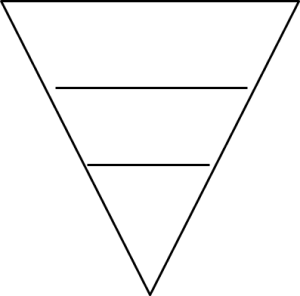
carnivores – 12 gm / m2
herbivores – 8 gm / m2
producers – 4 gm / m2
Food Web
- A food web is a system of interconnected and interdependent food chains.
- It can also be defined as a network of food relationships through which nutrients and energy are passed from one living organism to another. Food web is a series of organisms related by predator, prey and consumer, resource interactions; the entirety of interrelated food chains in an ecological community.
Biogeochemical Cycles
- In geography and Earth science, a biogeochemical cycle or substance turnover or cycling of substances is a pathway by which a chemical element or molecule moves through both biotic and abiotic compartments of Earth.
Nitrogen Cycle
- Nitrogen is required for the manufacturing of all amino acids and nucleic acids; however, the average organism cannot use atmospheric nitrogen for these tasks and as a result is dependent on the nitrogen cycle as a source for its usable nitrogen.
- The nitrogen cycle begins with nitrogen stored in the atmosphere as N2 or nitrogen stored in the soil as ammonium (NH4+), ammonia (NH3), nitrite (NO2−), or nitrate (NO3−).
- Nitrogen is assimilated into living organisms through three stages: nitrogen fixation, nitrification, and plant metabolism.
- Nitrogen fixation is a process which occurs in prokaryotes in which N2 is converted to (NH4+).
- Atmospheric nitrogen can also undergo nitrogen fixation by lighting and UV radiation and become NO3-. Following nitrogen fixation, nitrification occurs.
- During nitrification, ammonia is converted into nitrite, and nitrite is converted into nitrate.
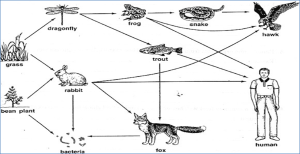
- Nitrification occurs in various bacteria. In the final stage, plants absorb ammonia and nitrate and incorporate it into their metabolic pathways.
- Once the nitrogen has entered the plant metabolic pathway, it may be transferred to animals when the plant is eaten.
- Nitrogen is released back into the cycle when denitrifying bacteria convert NO3- into N2 in the process of denitrification,
- When detritivorous bacteria convert organic compounds back into ammonia in the process of ammonification, or when animals excrete ammonia, urea, or uric acid.
- A lot of environmental problems are caused by the disruption of the nitrogen cycle by human activity some of the problems caused range from the production of tropospheric (lower atmospheric) smog to the perturbation of stratospheric ozone and contamination of ground water.
- An example of one of the problems caused is the formation of greenhouse gas.
- Like carbon dioxide and water vapor greenhouse gas traps heat near the earth’s surface and destroys the stratospheric ozone.
- Once that occurs nitrous oxide in the earth’s atmosphere is broken down by UV light into nitrogen dioxide and nitric oxide.
- These two products can reduce the ozone.
- Nitrogen oxides can be changed back into nitrates and nitrite compounds and recycled back into the earth’s surface.
- The non disturbance of eco system
- It is naturally done by bio geo chemical cycles.
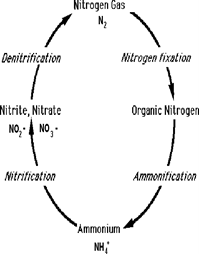
ECOLOGY & ENVIRONMENT
- But the activities of humans the land, water, air is polluted leads to harmful effects to eco systems
- They are classified as follows
- land pollution
- water pollution
- air pollution
- sound pollution
- radioactive pollution
Carbon Cycle
- Carbon is required for the building of all organic compounds.
- Carbon in the form of carbon dioxide (CO2) is obtained from the atmosphere and transformed into a usable organic form by organisms.

- The reservoirs for the carbon cycle are the atmosphere, where carbon dioxide exists as a free gas, fossil organic deposits (such as oil and coal), and durable organic materials like cellulose.
- Mineral carbonates, such as limestone, are a significant geological sink for carbon.
- During the process of carbon fixation, carbon dioxide is taken up from the atmospheric reservoir (or from biocarbonates dissolved in water) by plants, photosynthetic bacteria, and algae and is “fixed” into organic substances.
- Animals obtain their requirements for carbon (as carbon-based molecules) by eating plants or other animals.
- For the biological links, the carbon cycle comes full cycle when carbon is released by either plants and animals as they respire or after life as they decompose.
- Organisms respire carbon dioxide as a waste product from the breakdown of organic molecules as their cells derive energy from oxidizing the molecules containing “fixed” carbon.
- The burning of organic material such as wood or fuels also results in the release of carbon dioxide from organic carbon.
- CO2 is a trace gas and has huge effects on Earth’s heat balance by absorbing infrared radiation.
- During the growing season or summer, there is a decrease in atmospheric CO2 because increased sunlight and temperature helps plants increase their carbon dioxide uptake and growth.
- In the winter time, more CO2 enters the atmosphere than can be removed by plants.
- This happens because plant respirations and the death of plants happens faster than photosynthesis. Life and Biogeochemical Cycles.
Oxygen Cycle
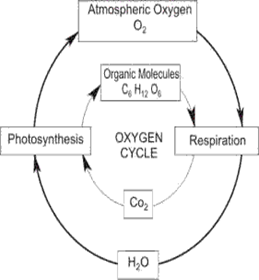
- The oxygen cycle is the biogeochemical cycle that describes the movement of oxygen within its three main reservoirs: the atmosphere (air), the total content of biological matter within the biosphere (the global sum of all ecosystems), and the lithosphere (Earth’s crust).
- Failures in the oxygen cycle within the hydrosphere (the combined mass of water found on, under, and over the surface of planet Earth) can result in the development of hypoxic zones.
- The main driving factor of the oxygen cycle is photosynthesis, which is responsible for the modern Earth’s atmosphere and life on earth (see the Great Oxygenation Event).
- By far the largest reservoir of Earth’s oxygen is within the silicate and oxide minerals of the crust and mantle (99.5%).
- Only a small portion has been released as free oxygen to the biosphere (0.01%) and atmosphere (0.36%).
- The main source of atmospheric free oxygen is photosynthesis, which produces sugars and free oxygen from carbon dioxide and water:
- Photosynthesizing organisms include the plant life of the land areas as well as the phytoplankton of the oceans.
- The tiny marine cyan bacterium Prochlorococcus was discovered in 1986 and accounts for more than half of the photosynthesis of the open ocean.
- An additional source of atmospheric free oxygen comes from photolysis, whereby high energy ultraviolet radiation breaks down atmospheric water and nitrous oxide into component atoms.
The free H and N atoms escape into space leaving O2 in the atmosphere:
- The main way free oxygen is lost from the atmosphere is via respiration and decay, mechanisms in which animal life and bacteria consume oxygen and release carbon dioxide.
- The lithosphere also consumes free oxygen via chemical weathering and surface reactions. An example of surface weathering chemistry is formation of iron- oxides (rust):
- Oxygen is also cycled between the biosphere and lithosphere. Marine organisms in the biosphere create calcium carbonate shell material (CaCO3) that is rich in oxygen.
- When the organism dies its shell is deposited on the shallow sea floor and buried over time to create the limestone sedimentary rock of the lithosphere.
- Weathering processes initiated by organisms can also free oxygen from the lithosphere. Plants and animals extract nutrient minerals from rocks and release oxygen in the process.
Pollution
- Pollution is the introduction into the air, water or ground of toxic substances that are damaging to human health and ecosystems.
- It is mainly linked with human activity: discharge of domestic, industrial and agricultural waste; application of pesticides by farmers; leaks of radioactive materials; gas emissions into the atmosphere etc.
Pollutants: Something that pollutes, especially a waste material that contaminates air, soil, or water.
Land pollution
- Land is the degradation of Earth’s land surfaces often caused by human activities and their misuse of land resources. It occurs when waste is not disposed properly.
- Haphazard disposal of urban and industrial wastes, exploitation of minerals, and improper use of soil by inadequate agricultural practices are a few factors.
- Urbanization and industrialization are major causes of land pollution.
- The Industrial Revolution set a series of events into motion which destroyed natural habitats and polluted the environment, causing diseases in both humans and other species of animals
Pollutants:
- Land pollution is the destruction of Earth’s land surfaces through misuse of land resources by human activities.
- Polluted land has deposits of liquid and solid waste such as rubbish, garbage, paper, glass and plastic objects.
Effects:
- When land pollution is bad enough, it damages the soil.
- This means that plants may fail to grow there, robbing the eco- system of a food source for animals.
- Eco-systems may also be upset by pollution when the soil fails to sustain native plants, but can still support other vegetation.
- Invasive weeds that choke off the remaining sources of native vegetation can spring up in areas that have been weakened by pollution.
Recycling
- One of the easiest things we can all do to improve our environment is to recycle wastes whenever possible. Recycling saves natural resources and energy and reduces the need for landfills or incinerators.
- It can also increase local jobs by collecting processing and manufacturing new products out of discarded materials.
- Efforts to reduce the use of plastics and to promote plastic recycling have occurred.
- g: Some supermarkets charge their customers for plastic bags, and in some places more efficient reusable or biodegradable materials are being used in place of plastics.
Bio plastic / natural plastic / biopal
- It is made up microorganisms known as alcaligenes by the process of disintegration
- It’s a homopolimer type
- It’s also called as polyhydroxybutrate.
Uses:
- Packaging such as milk bottles and water and soft drinks bottles is easily identified and hence setting up a recycling infrastructure has been quite successful in many parts of the world
- There are also concerns that bioplastics will damage existing recycling projects.
- Packaging made of PLA-blend bio-flex
- Medicine: artificial heart valves, serate dentition, bone fracture plates, artificial skin
WASTE GENERATION AND MANAGEMENT SOURCES OF WASTE:
Pollution of land mainly affects the soil and water due to accumulation of undesirable materials disposed off as a result of human activity (Fig. 19). The waste consists of garbage, paper, wood, cloth, plastic, iron scrap, food residue, farm waste etc., The municipal solid waste generated in Indian cities has increased from 480 lakh tonnes in1997 to 10 crore tonnes currently. The sources of waste generated in our day- to-day life are classified broadly into
- Domestic
- Industrial
- Agricultural and
- Commercial
SOLID WASTE MANAGEMENT
Sources | Activity | Types of Waste |
Residential | Single family, multi family, medium and high rise apartments | Garbage, Rubbish, ashes |
Industrial | Fabrication, light and heavy manufacturing refineries, power plants. | Garbage, rubbish, Chemical and special wastes. |
Open areas | Street, parks, vacant plots, play grounds, highways, beaches, etc. | Rubbish and special waste |
Treatment plant | Water, sewage and industrial waste treatment plant | Treatment plant waste |
Sources and Types of Solid waste Domestic Waste
- Waste generated from residential premises is called domestic waste.
Municipal waste
- The combined solid and liquid waste from residential, commercial and industrial sources are called municipal waste.
Industrial waste
All the unwanted materials generated from industries are called industrial wastes. The industrial wastes may be liquid, sludge, solid, gases, etc. The absence of adequate disposal facilities for the industries is a main factor for indiscriminate disposal of solid waste. It is mainly of three types
- Solid waste – Toxic – mining waste, Non-toxic – building materials.
- Liquid wastes – organic liquid waste and inorganic liquid waste.
- Organic liquid waste – effluents from tanneries / distilleries / sugar factories
- Inorganic liquid waste – from chemical and fertilizing industries
- Gaseous waste
- Toxic: toxic fumes like ammonia, Hydrogen sulphide etc.,
- Non – toxic: steam / water vapour
- Agricultural and Animal husbandry waste
- Agricultural and animal husbandry wastes are those generated by the rearing of animals and the production and harvest of crops or trees. It includes feed waste, non- edible oil seeds, straw, husk, coconut waste and cotton waste, rubber waste and its by products.
Commercial waste
- Most of the shops, restaurants, markets, offices are sources of commercial wastes like bottles, plastic bags, polythene, paper wrappers, non-biodegradable cups and wastes that are produced during construction of buildings etc.,
CLASSIFICATION OF WASTE
- Rapid industrialization and urbanization without due regard to environmental considerations are leading to extensive environmental pollution. The materials consumed during these activities reduces non-renewable resources, and generate The wastes are classified into bio-degradable, non-biodegradable, toxic, non- toxic and bio-medical wastes.
Biodegradable
- Any waste that is capable of undergoing decomposition by microbes are called biodegradable wastes. The food, garden wastes, paper and paper board are certain examples of bio-degradable wastes.
Non-biodegradable
- Non-biodegradable wastes are those that cannot be decomposed by bacteria. Waste like ceramics, aluminium cans, PVC articles, plastics, bottles etc are best example for non- biodegradable waste.
Toxic waste
- Any waste that are harmful to life and environment is known as toxic waste. The toxic waste may be poisonous, radioactive, corrosive, carcinogenic (causing cancer), mutagenic (damaging) (chromosomes), teratogenic (in nature).
- Toxic waste are produced during industrial, chemical and biological process. Even household office and commercial wastes contain small quantities of toxic wastes (e.g., Batteries, old pesticides). Paints, pesticides, toxic chemicals broken tube lights, expired medicines, etc., are some of the toxic wastes. The waste generated by the nuclear power plant such as heavy water or the spent nuclear fuel are highly hazardous to the environment and all life forms.
Non-toxic waste
- The wastes of non-hazardous category are called non-toxic wastes. They do not harm to life.
- Kitchen waste, garbage, street sweepings, roadside litter, etc. are some examples of non-toxic wastes.
Biomedical waste
- The wastes that are generated in hospitals are biomedical wastes. e.g., syringes, blades, needles, cotton, human body parts, soiled plasters etc.,
IMPACT OF WASTE ACCUMULATION
Spoilage of Landscape
- Sanitary landfill is commonly used for final disposal of solid wastes. The main disadvantage over open dumps is in the aspects of public health. The availability of land for the dumping of wastes is also a problem.
Pollution
- Land and soil pollution is responsible for loss of fertility and productivity of soil.
- The decomposition of the various types of waste material releases harmful gases and bad smell, which pollute the environment.
- The municipal and domestic waste is often discharged in water bodies, is responsible for water pollution
- The excreta of humans, animals and birds is a source of soil pollution by biological agents. Digested sewage sludge, used as a fertilizer also causes soil pollution.
Health hazard
- The radioactive wastes produced by nuclear testing laboratories and industries reach the soil and accumulate in the soil. Waste from nuclear reactors emit radiations are harmful to soil, plants and affects the health of human by causing cancer.
Effect on Terrestrial and aquatic life
- Most of the thermal and electric power plants discharge large quantities of hot water into streams or rivers. Hot water has lower dissolved oxygen level. So, thermal pollution is considered for the whole aquatic ecosystem. Due to a minimum concentration of oxygen, fishes and other marine organisms migrate from the polluted area or die in large numbers. Waste from industries such as insecticides, acids, alkalies etc. also destroy the growth of aquatic plants.
NEED FOR MANAGEMENT OF WASTE
- Waste can be converted into new products using technology. Used or unused wastes cause a great hazard to the human environment. Utilization and reducing of waste is a complex field. In waste management, there is a need for techno- economic studies. To live in a better way, the quantity of wastes should be minimized by controlling wastes from industry, agriculture, urban areas etc., we can protect the health of future generation and also the environment.
- Due to expansion of industrial activities and growth of population, we are using more resources and producing more wastes. The waste disposal is expensive and also cause pollution to environment. Much of our waste could be minimized by our waste management plans by means of the following three methods (Three ‘R’s). They are as follows.
- First Reduce the waste
- Then Re-use items or articles
- Then Recycle them for further use and finally dispose of what is left.
Waste | Recycling Possibilities |
Paper | • Use of scrap paper or personal stationery, exchange magazines and newspapers with friends, repulp to reclaim fibre, Compost, Incinerate heat |
Glass | • Purchase drinks in deposit bottles and return them, use other bottles as storage bins in the home, Crush and remelt for glass manufacture Crush and use as aggregate for building, material or antiskid additive for road surface. |
Tyre | • Recap usable casings • Use of swings, crush guards, boat bumpers, etc., • Shred and use of manufacture of new tyres Grind and use as additive in road construction |
Manure | • Compost or spread directly on fields • Pertinent to yield methane, use residue as compost • Convert to oil by chemical treatment • Treat chemically and re-use as animal feed |
Food scraps | • Save for meals of leftovers • Sterilize and use as hog food • Compost • Use as culture for yeast for food production • Sterilize and use as animal feed |
METHODS OF SAFE DISPOSAL OF WASTES
- The methods of disposal of wastes can be carried out by segregation, dumping, composting, drainage, treatment of effluents before discharge, incineration and sue of scrubbers and electrostatic precipitators.
Segregation
- The waste materials of non- biodegradable type like glass, plastics etc and bio-degradable like paper and organic materials are separated before being disposed off.
Dumping
- Attempt of depositing solid wastes upon land is known as dumping. The segregated wastes are dumped separately for further process of management.
Composting
- It is a biological process of decomposing organic materials such as fallen leaves, grass clippings, kitchen wastes, garden wastes, food wastes etc., by microbes.
Drainage
- Wastewater and sewage must be taken away from all buildings through gully. In urban areas the rain water cannot drain into the grounds. Therefore, the excess rain water are nowadays drained by soak ways or by down pipes in to the well to harvest the rain water.
Treatment of effluents before discharge
- In urban areas two drainage systems are found. One is designed to collect clean rainwater and the other is to collect foul sewer from toilet and sink wastes. The dirty water including industrial wastes and domestic wastes are let into a treatment tank. In the treatment tank, the drained effluents are biodegraded before returning to river. The sewage sludge formed during treatment process are recycled as fertilizers.
Incineration
- It is destruction of waste by controlled burning at high temperature. It is the best way to dispose of pharmaceuticals wastes. It is an environmentally and technically superior method of waste disposal.
Scrubbers
- The Scrubbers are another device, which saturate the gas stream in order to remove the dry fly ash. Particulate vapours and gases are controlled by this device. Scrubbers are used on coal mining power plants, asphalt, concrete plants which are emitting sulphur dioxide and hydrogen sulphide.
Electrostatic precipitator
- Electrostatic precipitator is a device developed to reduce the serious smoke nuisances. Today it is found mainly on large power plants, cement plants, incinerators and various boiler applications. Electrostatic precipitators are 99 effective instrument for the attraction of particle emitted power plants, paper mill etc.,
NEED FOR REDUCING, RE- USING AND RECYCLING WASTES
Reduce of Waste
We can reduce the waste by way of consuming and throwing away less. It includes:
- Purchasing of durable and long lasting goods
- Buying products with packaging that are as free of toxic as possible.
- Avoid disposable products.
- Get drinks in returnable products
- Repair rather than buy a new one
- Compost kitchen and garden waste.
Re-use of Wastes
After reducing the waste, we need to think about reusing of goods. Reusing involves neither additional energy consumption nor for raw materials. The following are certain methods for re-use of products which are likely to be thrown away as wastes.
- Donate unwanted goods to charity club
- Purchasing refillable pens
- Refill the water bottles
Recycle of Wastes
- Converting of waste materials into valuable new materials or products is termed as recycling of wastes. This method of waste management generates environmental, financial and social benefits. Materials like glass, metals, plastics and paper can be processed into new products.
LEGAL PROVISIONS FOR HANDLING AND MANAGEMENT OF WASTES
- The Government has framed several rules and guidelines on the management and handling of hazardous waste. These rules are implemented through State pollution control boards (SPCBs) and pollution control committees in states.
- India is one of the first countries, which has provided a protection for the improvement of environment in its constitution. The article 51.A(g) of the constitution states the responsibility of every citizen to protect the environment. Among the existing environmental Protection Act, the act such as “Hazardous Waste (Management and Handling) Rules, 1989” and “Biomedical Wastes (Management and Handling) Rules, 1996 are providing some legal provisions for handling and management of solid wastes.
WATER
- Water pollution refers to the contamination of water bodies such as rivers, oceans, lakes, and groundwater caused by human activities.
- This can be harmful to plants and organisms which live in these water bodies.
- The pollutants undergo many reactions and can become hazardous.
- 70 % of India’s fresh water is polluted, including several high-altitude lakes.
- While water pollution is easier to study and manage, its control is highly complex and very costly.
- Water pollution is defined as presence of any foreign substance (organic, inorganic, biological or radiological) in quality so as to constitute a hazard, or impair the usefulness of water.
- It contains various types of impurities such as dissolved gases, dissolved minerals, suspended matters and even microbes.
- Per day a man consumes around 50 lts of water for drinking, washing, cooking and for maintenance of body
- On the basis of availability of water for a year to a man, India stands on 133th place
- In human body two third of water is present.
- In India, the renewable water capacity is 1897 sq kilo meters / per year
- WHO states that would be heavy water scarcity by 2025
Water Cycle
A very significant molecule (on planet Earth) that cycles through ecosystems is the water molecule (H2O), for the reason that life is so dependent on water as the medium of chemical reactions within cells.
- While it generally is the case that we discuss the water cycle in terms of the various states of water, at least some water molecules are taken up by plants and split apart (photolysed) into atoms of hydrogen and oxygen; the latter is released into the atmosphere as molecular oxygen (O2).
- Thus, by virtue of photosynthesizing organisms (photoautotrophs), the water cycle is an important part of both the oxygen and the hydrogen cycles.
- Note that hydrogen ends up as part of an organic molecule, and therefore a participant in the carbon cycle.
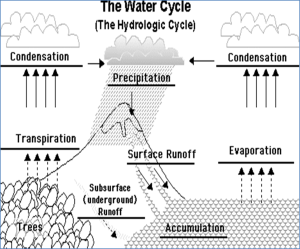
- The majority of water in the water cycle is found within the oceans and the polar ice caps, although water is present in the bodies of organisms, in freshwater lakes and rivers, frozen in glaciers, and in the ground as groundwater.
- Water moves more or less freely between these storage reservoirs: by evaporation, by precipitation, and by runoff from the land.
- The sedimentation cycle is an extension of the hydrological cycle. The water carries material from the land to the ocean, where they are added as sediments.
- The sediment cycle includes the physical and chemical erosion, nutrient transport, and sediment formation from water flows.
- The sedimentation cycle is an extension of the hydrological cycle. The water carries material from the land to the ocean, where they are added as sediments.
- The sediment cycle includes the physical and chemical erosion, nutrient transport, and sediment formation from water flows.
- The sediment formed from water flows is mostly responsible for the buildup of sediments at the bottom of the ocean. The sediment cycle is tied in with the flow of six important elements, which are hydrogen, carbon, oxygen, nitrogen, phosphorus and sulfur. These elements also known as microelements make up 95 % of all living things.
- The balancing of these molecules is required to sustain life. These elements have to be recycled for life to continuously regenerate.
Decrease of Water
1.Natural reasons:
- Low amount of rainfall and hot air will decrease the ground water level
2.Human activities:
- Deforestration, population explasion, fast urbanization, and
3.Commercial water :
- Some private organization make use of more water from rivers will leads to lower level of ground water.
- eg : Tiruppur dyeing factories –Noyyal river
4.Agricultural reasons:
- Basically, India is an agricultural based nation.
- So, the usage of water is always high.
WATER MANAGEMENT
- Water resource management is the activity of planning, developing, distributing and managing the optimum use of water resources. It is a sub-set of water cycle management.
1.Cloud Seeding :
- A form of intentional weather modification, is the attempt to change the amount or type of precipitation that falls from clouds, by dispersing substances into the air that serve as cloud condensation or ice nuclei, which alter the microphysical processes within the cloud.
- The usual intent is to increase precipitation (rain or snow), but hail and fog suppression are also widely practiced in airports.
2.Rainwater harvesting:
- Rainwater harvesting is the accumulation and deposition of rainwater for reuse before it reaches the aquifer.
- Uses include water for garden, water for livestock, water for irrigation, etc. In many places the water collected is just redirected to a deep pit with percolation.
Uses:
- Makes use of a natural resource and reduces flooding, storm water, erosion, and contamination of surface water with pesticides, sediment, metals and fertilizers.
- Excellent source of water for landscape irrigation, with no chemicals such as fluoride and chlorine, and any dissolved salts and minerals from the soil.
- Home systems can be relatively simple to install and operate and it may reduce your water bill.
- Promotes both water and energy conservation.
3.Dams, Reservoirs, Canals
- By constructing these we can able be to store excess amount of water from the river.
4.Watershed management
- Watershed management is the study of the relevant characteristics of a watershed aimed at the sustainable distribution of its resources and the process of creating and implementing plans, programs, and projects to sustain and enhance watershed functions that affect the plant, animal, and human.
5.Icebergs drinking water:
- The concept of using icebergs as a water source has been around for a long time. It has always been seen as something that is vaguely possible one day in the not too far distant future.
6.Storage in wet land:
- Main purpose is for drinking Transportation purpose and also for taking one place to another place.
7.Saving in Houses:
- Due to some changes in our daily activities we can able to save some amount of water daily
8.Purification of Sea Water:
- Reverse osmosis is most commonly known for its use in drinking water purification from seawater, removing the salt and other effluent materials from the water molecules.
- It is very expensive method
9.Saving in factories:
- The coolant used in machineries is to be recycled again and again.
Water Pollution
- Water pollution is the contamination of water bodies (e.g. lakes, rivers, oceans, aquifers and groundwater).
- Water pollution occurs when pollutants are directly or indirectly discharged into water bodies without adequate treatment to remove harmful compounds.
- Water pollution affects plants and organisms living in these bodies of water.
- In almost all cases the effect is damaging not only to individual species and populations, but also to the natural biological communities.
Reasons for water pollution:
- Factory waste
- Soil Erosion
- Oil waste
- Domestic waste Control measures:
- Cleaning of waste water before liberated in water sources.
- Avoid of fertilizers, insecticides and weedicides.
- Avoid more usage of water
- Domestic used water used in gardens.
- Nitrosomonas Europhea – bacteria is used to demolish the microorganisms in domestic waste water.
- Eucalyptus trees can absorb minerals from waste water.
- Implementing law full act.
- Awareness in peoples.

Air pollution
- Air pollution is the introduction of chemicals, particulates, biological materials, or other harmful materials into the Earth’s atmosphere, possibly causing disease, death to humans, damage to other living organisms such as food crops, or the natural or built environment.
- The atmosphere is a complex natural gaseous system that is essential to support life on planet Earth.
- Stratospheric ozone depletion due to air pollution has long been recognized as a threat to human health as well as to the Earth’s ecosystems
Composition of air
- nitrogen O2 – 78%
- Argan Co2 – 20.9%
- Water vapour – 0.9%
- 03%
- Less amount
Causes of Air pollution:
1.Natural sources:
- Volcanoes, forest fire, sea water salinity, photo chemical oxidation, pollens, sperms, radioactive elements in earth crust, radiation in atmosphere.
Pollutants | Sources | Effect |
Carbon monoxide | Fuels | Death of humans |
Carbon dioxide | Coal, petrol | Global warming |
Nitrogen oxide | Vehicles | Acid rain |
Sulphur di oxide | Factories | Cancer, asthma |
Carbon | Coal mines | Black lung disease |
CFC | Fridge, Air cooler, solvents | Ozone depletion, cancer |
Methyl Iso Cyanide | Bhopal–union carbide factory | Many death, disease |
2.Human activity sources / anthropogenics :
- Mainly of factory song
Acid Rain
- Rainfall made so acidic by atmospheric pollution that it causes environmental harm, chiefly to forests and lakes.
- The main cause is the industrial burning of coal and other fossil fuels, the waste gases from which contain sulphur and nitrogen oxides which combine with atmospheric water to form acids.
- Co2 + H2o H2Co3 carbonic acid
- So2 + H2o H2So4 sulphuric acid
- No2 + H2o HNo3 nitric acid
Causes
- Burning of fossil fuels like coal.
- Vehicle emission
- Burning of forests and grasslands
- Release of gases from chemical industries.
Effects:
- Soil acidity: eco system is affected.
- Water acidity: pond, river are affected,
- Human impact: ground water spoilage, eye and skin irritation
- Building impact: Tajmahal is affected.
Ozone Depletion
- Ozone depletion describes two distinct but related phenomena observed since the late 1970s: a steady decline of about 4% per decade in the total volume of ozone in Earth’s stratosphere, and a much larger springtime decrease in stratospheric ozone over Earth’s Polar Regions.
- The latter phenomenon is referred to as the ozone hole.
- In addition to these well-known stratospheric phenomena, there are also spring time polar tropospheric ozone depletion events.
- The details of polar ozone hole formation differ from that of mid- latitude thinning, but the most important process in both is catalytic destruction of ozone by atomic halogens.
- The main source of these halogen atoms in the stratosphere is photo dissociation of man- made halocarbon refrigerants, solvents, propellants, and foam-blowing agents (CFCs, HCFCs, freons, halons).
- These compounds are transported into the stratosphere after being emitted at the surface.
- Both types of ozone depletion have been observed to increase as emissions of halo-carbons increased.
- CFCs and other contributory substances are referred to as ozone-depleting substances (ODS).
- Since the ozone layer prevents most harmful UVB wavelengths (280–315 nm) of ultraviolet light (UV light) from passing through the Earth’s atmosphere, observed and projected decreases in ozone have generated worldwide concern leading to adoption of the Montreal Protocol that bans the production of CFCs, halons, and other ozone-depleting chemicals such as carbon tetrachloride and trichloroethane
- It is suspected that a variety of biological consequences such as increases in skin cancer, cataracts, damage to plants, and reduction of plankton populations in the ocean’s photic zone may result from the increased UV exposure due to ozone depletion.
Ozone O2 cycle:
- Three forms (or allotropes) of oxygen are involved in the ozone-oxygen cycle: oxygen atoms (O or atomic oxygen), oxygen gas (O2 or diatomic oxygen), and ozone gas (O3 or triatomic oxygen).
- Ozone is formed in the stratosphere when oxygen molecules photo dissociates after absorbing an ultraviolet photon whose wavelength is shorter than 240 nm.
- This converts a single O2 into two atomic oxygen radicals.
- The atomic oxygen radicals then combine with separate O2 molecules to create two O3 molecules.
- These ozone molecules absorb UV light between 310 and 200 nm, following which ozone splits into a molecule of O2and an oxygen atom.
- The oxygen atom then joins up with an oxygen molecule to regenerate ozone.
- This is a continuing process that terminates when an oxygen atom “recombines” with an ozone molecule to make two O2 molecules.
2 O3 →3 O2 chemical equation
- The overall amount of ozone in the stratosphere is determined by a balance between photochemical production and recombination.
- Ozone can be destroyed by a number of free radical catalysts, the most important of which are the hydroxyl radical (OH•), the nitric oxide radical (NO•), atomic chlorine ion (Cl•) and atomic bromine ion (Br•).
- The dot is a common notation to indicate that all of these species have an unpaired electron and are thus extremely reactive.
- All of these have both natural and man-made sources; at the present time, most of the OH• and NO• in the stratosphere is of natural origin, but human activity has dramatically increased the levels of chlorine and bromine.
- These elements are found in certain stable organic compounds, especially chlorofluorocarbons (CFCs), which may find their way to the stratosphere without being destroyed in the troposphere due to their low reactivity.
- Once in the stratosphere, the Cl and Br atoms are liberated from the parent compounds by the action of ultraviolet light, e.g.
CFCl3 + electromagnetic radiation → CFCl 2 + Cl
- The Cl and Br atoms can then destroy ozone molecules through a variety of catalytic cycles.
- In the simplest example of such a cycle, a chlorine atom reacts with an ozone molecule, taking an oxygen atom with it (forming ClO) and leaving a normal oxygen molecule.
- The chlorine monoxide (i.e., the ClO) can react with a second molecule of ozone (i.e., O3) to yield another chlorine atom and two molecules of oxygen. The chemical shorthand for these gas- phase reaction.
- The chlorine atom changes an ozone molecule to ordinary oxygen
ClO + O3 → Cl + 2 O2
- The ClO from the previous reaction destroys a second ozone molecule and recreates the original chlorine atom, which can repeat the first reaction and continue to destroy ozone.
- CFCs and related compounds in the atmosphere
- Chlorofluorocarbons (CFCs) and other halogenated ozone depleting substances (ODS) are mainly responsible for man-made chemical ozone depletion.
- The total amount of effective halogens (chlorine and bromine) in the stratosphere can be calculated and are known as the equivalent effective stratospheric chlorine.
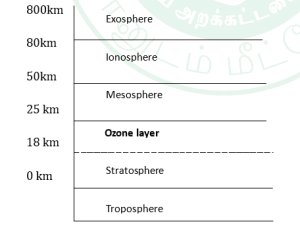
Effects:
- Skin cancer
- Cataract
- Melanin pigment change
- Global warming
Green House Effect
- The trapping of the sun’s warmth in a planet’s lower atmosphere, due to the greater transparency of the atmosphere to visible radiation from the sun than to infrared radiation emitted from the planet’s surface.
- The greenhouse effect is a process by which thermal radiation from a planetary surface is absorbed by atmospheric greenhouse gases, and is re-radiated in all directions.
- Since part of this re-radiation is back towards the surface and the lower atmosphere, it results in an elevation of the average surface temperature above what it would be in the absence of the gases
- CO2 is produced by fossil fuel burning and other activities such as cement production and tropical deforestation Greenhouse gases are those that can absorb and emit infrared radiation, but not radiation in or near the visible spectrum.
- In order, the most abundant greenhouse gases in Earth’s atmosphere are:
- Carbon dioxide (CO2) – 60%
- Methane (CH4) – 20%
- Nitrousoxide (N2O) – 16%
- CFCs – 6%
- Ozone (O3)
- Watervapor (H2O)
- The Earth receives energy from the Sun in the form UV, visible, and near IR radiation, most of which passes through the atmosphere without being absorbed.
- Of the total amount of energy available at the top of the atmosphere (TOA), about 50% is absorbed at the Earth’s surface.
- Because it is warm, the surface radiates far IR thermal radiation that consists of wavelengths that are predominantly much longer than the wavelengths that were absorbed (the overlap between the incident solar spectrum and the terrestrial thermal spectrum is small enough to be neglected for most purposes).
- Most of this thermal radiation is absorbed by the atmosphere and re-radiated both upwards and downwards; that radiated downwards is absorbed by the Earth’s surface.
- This trapping of long-wavelength thermal radiation leads to a higher equilibrium temperature than if the atmosphere were absent
Control devices
- The following items are commonly used as pollution control devices by industry or transportation devices.
- They can either destroy contaminants or remove them from an exhaust stream before it is emitted into the atmosphere.
Particulate control
- Mechanical collectors (dust cyclones, multicyclones)
- Electrostatic precipitators (ESP), or electrostatic air cleaner is a particulate collection device that removes particles from a flowing gas (such as air) using the force of an induced electrostatic charge.
- Electrostatic precipitators are highly efficient filtration devices that minimally impede the flow of gases through the device, and can easily remove fine particulates such as dust and smoke from the air stream.
- Baghouses Designed to handle heavy dust loads, a dust collector consists of a blower, dust filter, a filter-cleaning system, and a dust receptacle or dust removal system (distinguished from air cleaners which utilize disposable filters to remove the dust).
- Particulate scrubbers Wet scrubber is a form of pollution control technology.
- The term describes a variety of devices that use pollutants from a furnace flue gas or from other gas streams.
- In a wet scrubber, the polluted gas stream is brought into contact with the scrubbing liquid, by spraying it with the liquid, by forcing it through a pool of liquid, or by some other contact method, so as to remove the pollutants.
Sound Pollution
- Noise pollution is the disturbing or excessive noise that may harm the activity or balance of human or animal life.
- The source of most outdoor noise worldwide is mainly caused by machines and transportation systems, Noise pollution is a major problem in countries such as India during the festivals of Diwali, Navaratri, and Ganpati.
- The government of India has regulations against firecrackers and loudspeakers, but enforcement is extremely lax. Vehicle, aircraft, and trains. Outdoor noise is summarized by the word environmental noise.
- Poor urban planning may give rise to noise pollution, since side- by-side industrial and residential buildings can result in noise pollution in the residential areas.
- Noise pollution is measured by decibel units.
- Jet plans – 145 db
- Traffic – 90 db
- Vaccum cleaner – 85 db
- Speech – 60 db
Effects:
- Hearing loss
- Cardiovascular effects
- Stress
- Annoyance
- Child physical development
- The skin, the largest organ of the body, protects the internal system from knocks, scrapes and cuts; senses changes in the environment;
- The main route for air pollutants is through the nose, mouth and throat.
- The nose is very efficient at trapping and holding some inhaled pollutants.
- Concentrations of chemicals build up in the nose as the air is cleaned.
- The pollutants that accumulate in the nose can cause problems in the nose and sinuses or be absorbed in mucus membranes, resulting in a number of harmful effects on the body.
Radio Active Pollution
- Radioactive wastes are wastes that contain radioactive material. Radioactive wastes are usually by-products of nuclear power generation and other applications of nuclear fission or nuclear technology, such as research and medicine.
- Radioactive contamination, also called radiological contamination, is the deposition of, or presence of radioactive substances on surfaces or within solids, liquids or gases (including the human body), where their presence is unintended or undesirable.
- Such contamination presents a hazard because of the radioactive decay of the contaminants, which emit harmful ionising radiation such as alpha or beta particles, gamma rays or neutrons.
Effects:
- The impact Long-term exposure or exposure to high amounts of radiation can have far more serious health effects.
- Radioactive rays can cause irreparable damage to DNA molecules and can lead to a life- threatening condition. Prolonged exposure leads to a large number of molecules in the body being ionized into free radicals.
- Free radicals promote the growth of cancerous cells, i.e. tumors, in the body. People with heavy radiation exposure are at a very high risk for cancers
- The impact of radioactive pollution on human beings can vary from mild to fatal; the magnitude of the adverse effects largely depends on the level and duration of exposure to radioactivity.
- Low levels of localized exposure may only have a superficial effect and cause mild skin irritation.
Preventive Measures:
- Out coming of Radioactive waste is to be avoided
- Radioactive waste is to be eliminated in safe manner.
- Precautionary measures is to be taken before the construction of nuclear breeders.
- Controlled atom bomb test is essential.
ENVIRONMENTAL POLLUTION – CAUSE AND EFFECT
Emerging life styles in modern societies
- Earth is the only planet known so far to have life in the solar system. Conditions on earth when life just originated were very different from what they are today. As condition changed, there evolved more and more varied forms of life.
- Primitive man’s needs were modest gradually he discovered fire and invented tools and techniques. The invention and widespread use of different kinds of machineries brought about the Industrial revolution. This may be considered as a boon as well as bane to humanity.
- Some of our ‘technological progresses’ have seriously affected our air, water, land, forests, plants and animals.
Because of the increase in population, we use up the resources excessively. We do not have control over the use of natural resources. We convert the forests into living places. Thus. we stop the rain which is a major natural source of water. Since forests disappear fast, we are causing soil erosion yet another damage to natural resource.
- The rapidly increasing population has led to an increase in the consumption of energy. The increasing consumption of fuels such as coal and petroleum is an alarming issue because already the world is running short of these fuels. Major amount of our precious foreign exchange goes out only for importing crude oil & petroleum products.
- The modern life style of man has ushered in the production and the usage of synthetic materials such as plastics, detergents, paints, refrigents etc. There are both advantages and disadvantages of using these synthetic materials.
Plastic: Advantages
- Plastics are attractive and they are available in various forms.
- They are easy to handle
- Plastic bags are convenient for packing.
Disadvantages
- Plastics are not easily degradable
- They affect the soil fertility when dumped in the soil. They block the sewers.
- The plastic bags cause serious problems if they are swallowed by animals.
- Health will be affected if low quality plastics are used.
- When burnt, plastic produces toxic gases.
- Wastes generated from plastic manufacturing industries are toxic.
Advantages of Detergents
- Good fragrance, better lather formation and quick result in removing dirt.
Disadvantages
Waste water mixed with detergents when discharged affects soil fertility. Quantity of water used for rinsing is comparatively more because of excessive lather. Sometimes they are the cause of skin allergies.
Factors affecting environment
- There are many factors which affect our environment adversely, ego over and unplanned exploitation of resources, exploding population growth, industrialisation, use of synthetic materials etc. Man has started over using and over exploiting the natural resources such as, water, land, fuels etc which in turn cause the depletion or shortage of the resources. Over exploitation of the natural resources like forest, may result in shortage of fuel wood, changed climate, soil erosion, drought, etc.
The impact of the human activities on environment due to over population are as follows:
- Air pollution (automobile and industrial exhausts)
- Water pollution (Sewage from houses, effluents from industries)
- Land pollution (excessive use of fertilizers, non-degradable materials, pesticides, fungicides etc)
- Urbanisation (encroachment, deforestation)
Green chemistry
- Production of non-hazardous chemicals and avoiding its usage leads to green world.
Kyoto Protocol:
- The Kyoto Protocol to the United Nations Framework Convention on Climate Change is an international treaty that sets binding obligations on industrialised countries to reduce emissions of greenhouse gases.
- 1997 In December the countries conclude the Kyoto Protocol in Kyoto, Japan, in which they agree to the broad outlines of emissions targets.
Global Village:
- Global Village is a term closely associated with Marshall McLuhan,
- McLuhan described how the globe has been contracted into a village by electric technology and the instantaneous movement of information from every quarter to every point at the same time. In bringing all social and political functions together in a sudden implosion, electric speed heightened human awareness of responsibility to an intense degree.
Global Village Tech Park:
- Global Village Tech Park is a Software Technology Park in Bangalore, India.
- The park is situated on Mysore Road, about 12 km away from the city railway station.
- Global Village Tech Park was constructed, and is owned, by the Coffee Day group under the brand name Tanglin. It is equipped with all modern facilities and boasts posh greenery inside the park.
INDIA ENVIRONMENT MOVEMENTS
M.S. Swaminathan Research Centre:
- M S Swaminathan Research Foundation (MSSRF) is a non- profit research organization and was established in 1988.
- MSSRF has all along been developing and following a pro- nature, pro-poor, pro-women and pro-sustainable on-farm and non-farm livelihoods through appropriate ecotechnology and knowledge empowerment.
Bishnois Movement:
- Khejarli which is a village in Jodhpur district of Rajasthan, India 26 km south-east of the city of Jodhpur.
- The Bishnois sacrificed their lives while protecting trees by hugging to them.
Chipko movement:
- Act of hugging trees to protect them from being felled.
- By the 1980s the movement had spread throughout India and led to the formulation of people-sensitive forest policies, which put a stop tothe open felling of trees in regions as far reaching as Vindhyas and the Western Ghats. Today, it is seen as an inspiration and a precursor for Chipko movement of Garhwal.
- Its leader was Sunderlal Bahuguna.
Silent Valley Movement:
- Silent Valley was a social movement aimed at the protection of Silent valley, an evergreen tropical forest in the Palakkad district of Kerala, India.
- It was started in 1973 to save the Silent Valley Reserve Forest from being flooded by a hydroelectric project. The valley was declared as Silent Valley National Park in 1985.
- The Kuntipuzha is a major river that flows 15 km southwest from Silent Valley. It takes its origin in the lush green forests of Silent valley.
- In 1928 the location at Sairandhri on the Kunthipuzha River was identified as an ideal site for electricity generation.
- A study and survey was conducted in 1958 of the area about the possibility of a hydroelectric project of 120 MV and one costing Rs. 17 Crore was later proposed by the Kerala State Electricity Board.
Narmada Bachao Andolan Movement:
- Narmada Bachao Andolan (NBA) is a social movement consisting of adivasis, farmers, environmentalists, and human rights activists against a number of large dams being built across the Narmada River.
- The river flows through the states of Gujarat, and Madhya Pradesh in India.
- Sardar Sarovar Dam in Gujarat is one of the biggest dams on the river and was one of the first focal points of the movement.
- Narmada Bachao Andolan, with its leading spokespersons Medha Patkar and Baba Amte.
Blue cross movement:
- Animal welfare is main motive.
Global Warming
- Earth has warmed at an unprecedented rate over last hundred years and particularly over the last two decades. There is also an upsurge in the amount of extreme weather events, such as wildfires, heat waves and tropical storms. This is particularly because of the Global Warming.
- Global Warming is the increase of Earth’s average surface temperature due to effect of greenhouse gases, such as carbon dioxide emissions from burning fossil fuels or from deforestation, which trap heat that would otherwise escape from Earth. This is a type of greenhouse effect.
Ocean acidification
- Ocean acidification is the on-going decrease in the pH of the oceans, caused by the uptake of Carbon Dioxide (CO2) from the atmosphere.
- An estimated 30–40% of the carbon dioxide from human activity released into the atmosphere dissolves into oceans, rivers and lakes.
Climate change
- The term mitigation refers to efforts to cut or prevent the emission of greenhouse gases – limiting the magnitude of future warming.
- It may also encompass attempts to remove greenhouse gases from the atmosphere.
- It differs from climate change adaptation, which refers to the actions taken to manage the unavoidable.
